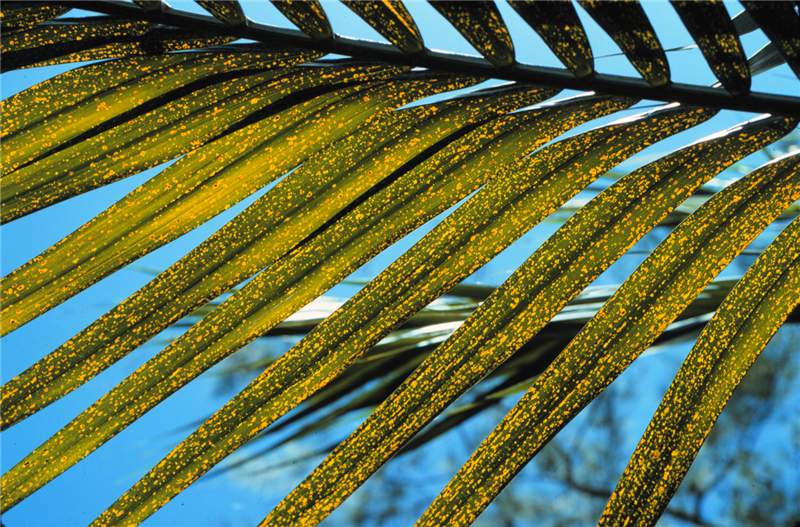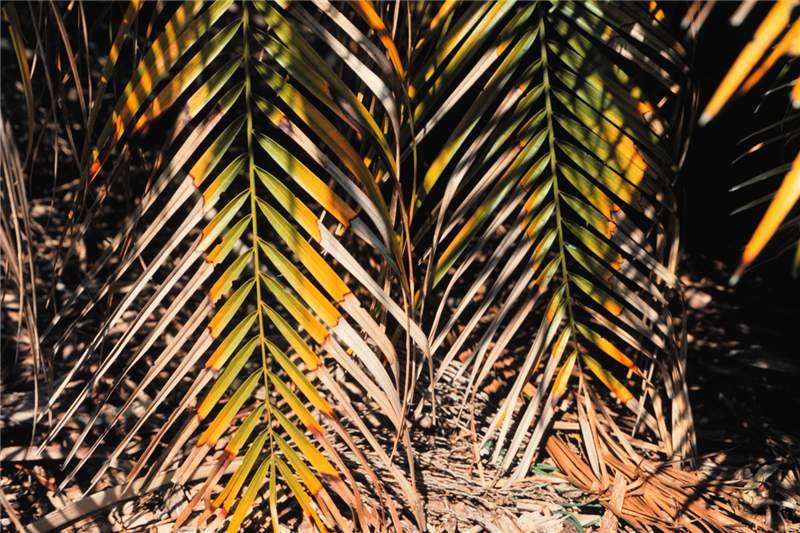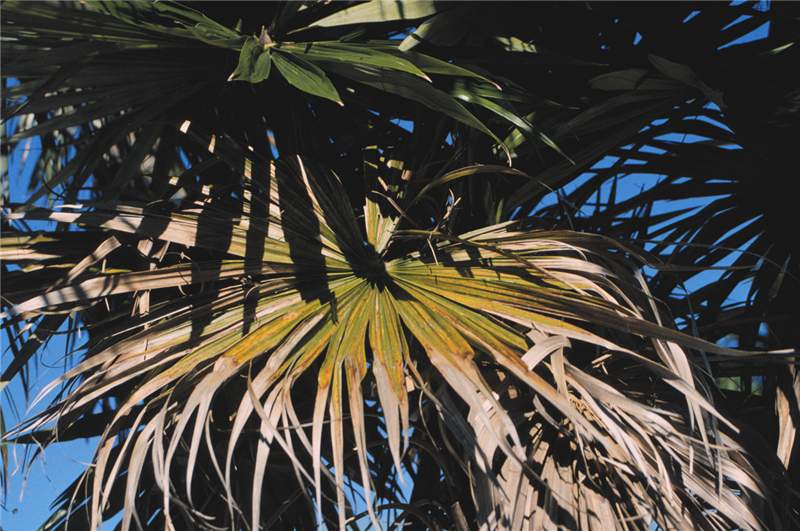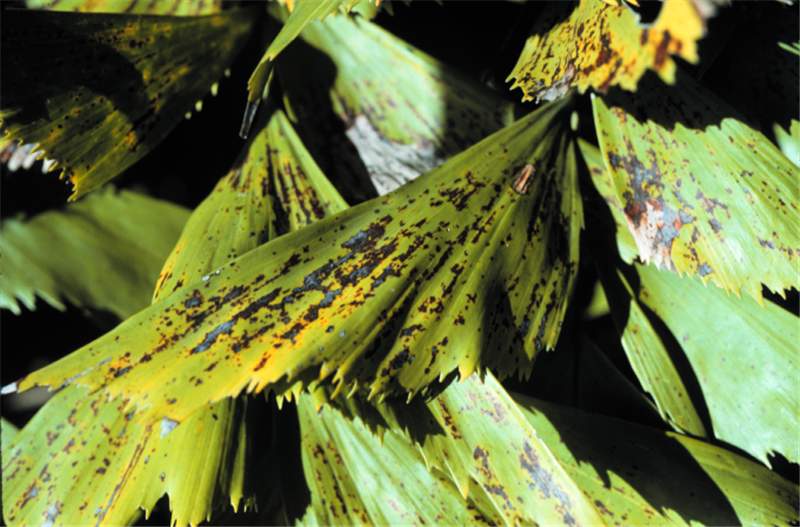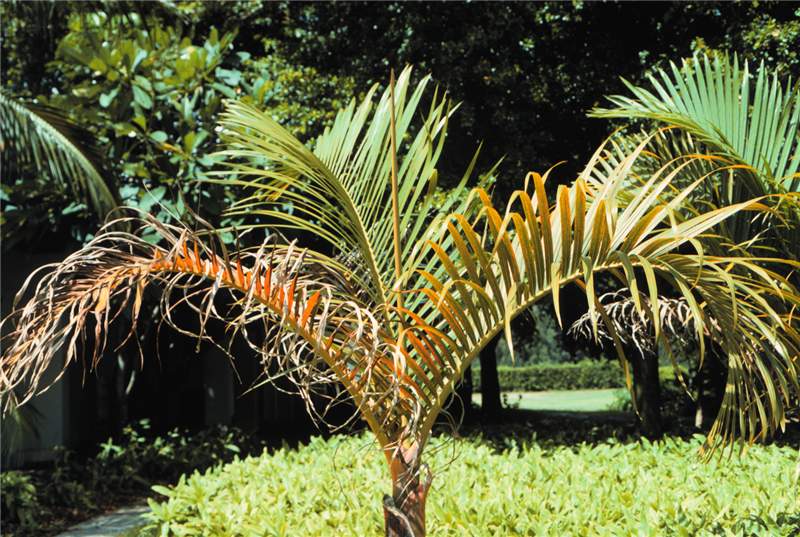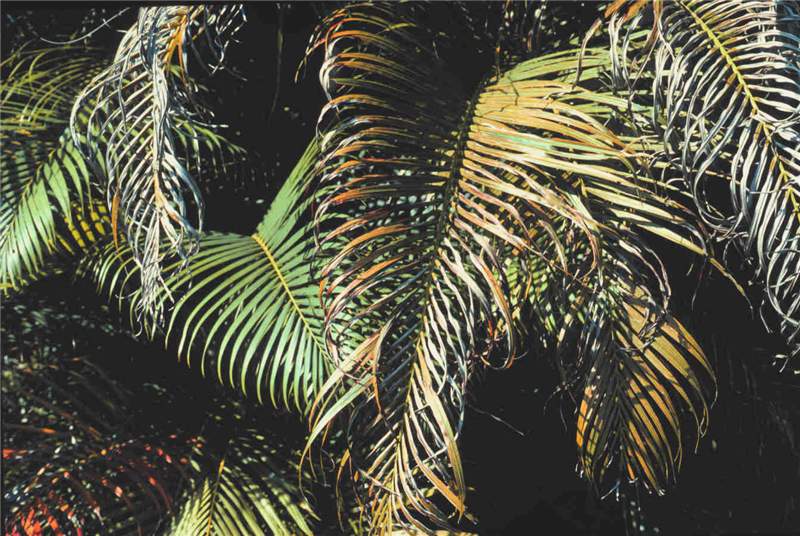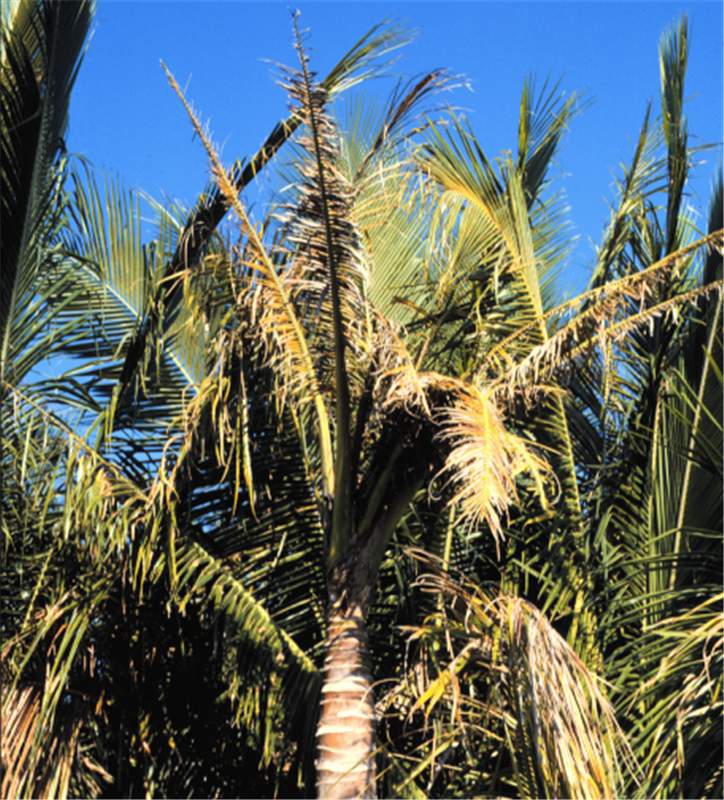Potassium Deficiency
|
Figure 2. Necrotic frizzled leaflets on older leaf of a potassium-deficient Dypsis cabadae. Photo by T.K. Broschat
|
|
Figure 1. Potassium deficient older leaf of Dictyosperma album showing translucent yellow-orange spotting. Photo by T.K. Broschat
|
|
Figure 4. Potassium-deficient older leaves of pygmy date palm (Phoenix roebelenii). Photo by T.K. Broschat
|
|
Figure 3. Potassium-deficient older leaf of Livistona chinensis showing leaf discoloration and leaflet tip necrosis. Photo by T.K. Broschat
|
|
Figure 6. Potassium deficiency symptoms on older leaf of Chamaerops humilis. Note the translucent orange and necrotic spotting. Photo by T.K. Broschat
|
|
Figure 5. Potassium deficiency symptoms on older leaves of fishtail palm (Caryota mitis). Photo by T.K. Broschat
|
|
Figure 8. Potassium-deficient spindle palm (Hyophorbe verschafeltii) showing increasing severity with leaf age. Photo by T.K. Broschat
|
|
Figure 7. Potassium deficient older leaf of areca palm (Dypsis lutescens) showing increasing severity towards the leaf tip. Photo by T.K. Broschat
|
|
Figure 10. Late stage potassium deficiency in coconut palm (Cocos nucifera) showing chlorotic, necrotic new leaves and tapered trunk. This palm died shortly after this photo was taken. Photo by T.K. Broschat
|
|
Figure 9. Severely potassium-deficient Sabal palmetto. Photo by T.K. Broschat
|
Symptoms
Symptoms of potassium (K) deficiency vary among species but always appear first on the oldest leaves. Older leaflets of some palms such as Dictyosperma album are mottled with yellowish spots that are translucent when viewed from below (Fig. 1). In other palms such as Dypsis cabadae, Howea spp. and Roystonea spp., symptoms appear on older leaves as marginal or tip necrosisnecrosis:
dead tissue, usually desiccated and brown to gray in color
with little or no yellowish spotting present. The leaflets in Roystonea, Dypsis, and other pinnate-leaved species showing marginal or tip necrosisnecrosis:
dead tissue, usually desiccated and brown to gray in color
often appear withered and frizzled (Fig. 2).
In fan palms such as Livistona chinensis, Corypha spp., Washingtonia spp., and Bismarckia nobilis, necrosisnecrosis:
dead tissue, usually desiccated and brown to gray in color
is not marginal but is confined largely to tips of the leaflets (Fig. 3). In Phoenix roebelenii, the distaldistal:
farthest from the point of attachment
parts of the oldest leaves are typically orange with leafletleaflet:
divisions of pinnate leaves
tips becoming necroticnecrotic:
see necrosis
. The rachisrachis:
the axis of a leaf beyond the petiole or an extension of the petiole into the leaf blade
of the leaves usually remains green, however, and the orange and green are not sharply delimited as with magnesium deficiency (Fig. 4). This pattern of discoloration holds for most palm species that show discoloration as a symptom. In P. canariensis, there may be little discoloration, but leaflets show fine (1-2 mm) necroticnecrotic:
see necrosis
spotting and extensive tip necrosisnecrosis:
dead tissue, usually desiccated and brown to gray in color
. These necroticnecrotic:
see necrosis
leafletleaflet:
divisions of pinnate leaves
tips in most Phoenix spp. are brittle and often break off, leaving the margins of affected leaves irregular.
In Caryota spp. and Arenga spp., chloroticchlorotic:
see chlorosis
mottling is minimal or non-existent, but early symptoms appear as irregular necroticnecrotic:
see necrosis
spotting within the leaflets and/or leafletleaflet:
divisions of pinnate leaves
tip necrosisnecrosis:
dead tissue, usually desiccated and brown to gray in color
(Fig. 5). In most other palms, including Cocos nucifera, Elaeis guineensis, Dypsis lutescens, Chamaerops humilis, Hyophorbe verschafeltii, and others, early symptoms appear as translucent yellow or orange spotting on the leaflets and may be accompanied by necroticnecrotic:
see necrosis
spotting as well (Fig. 6). As the deficiency progresses, marginal and tip necrosisnecrosis:
dead tissue, usually desiccated and brown to gray in color
will also be present. The most severely affected leaves or leaflets will be completely necroticnecrotic:
see necrosis
and frizzled except for the base of the leaf, leaflets, and the rachisrachis:
the axis of a leaf beyond the petiole or an extension of the petiole into the leaf blade
(Fig. 7). Symptoms decrease in severity from tip to base of a single leaf and from old to new leaves within the canopycanopy:
the cluster of leaves borne at the tip of the stem
(Figs. 7 and 8). In severe cases, the entire canopycanopy:
the cluster of leaves borne at the tip of the stem
will consist of a reduced number of leaves, all of which will be chloroticchlorotic:
see chlorosis
, frizzled, and stunted. The trunk will begin to taper (pencil-pointing) and death of the palm often follows (Figs. 9 and 10).
May be confused with
Manganese deficiency, leaf spot diseases, royal palm bug damage, soil salt injury, nutrient toxicities, water stress
Manganese (Mn) and potassium deficiencies can be extremely similar from a distance, but close examination should reveal characteristic spotting and marginal necrosisnecrosis:
dead tissue, usually desiccated and brown to gray in color
in K deficiency or necroticnecrotic:
see necrosis
streaking for Mn deficiency. Potassium deficiency symptoms are also more severe toward the leaf tip and are less so at the leaf baseleaf base:
the basal portion of a leaf petiole that is attached to the stem
. The reverse is true for Mn deficiency.
Leaf spot diseases are typically distributed throughout the canopycanopy:
the cluster of leaves borne at the tip of the stem
and not concentrated on the oldest leaves, but there are exceptions to this generalization.
Old damage from royal palm bugs appears similar to that of K deficiency on royal palms, but the leafletleaflet:
divisions of pinnate leaves
frizzling caused by royal palm bugs is typically observed in mid-canopy and extends the length of the leaf. K deficiency will be concentrated towards the tips of the oldest leaves in this species.
Soil salt injury, water stress, and various chemical toxicities also appear as tip necrosisnecrosis:
dead tissue, usually desiccated and brown to gray in color
concentrated towards the tips of the oldest leaves. Leaf nutrient or soil analyses may be helpful for distinguishing these similar disorders.
Cause
Potassium deficiency is caused by insufficient K in the soil but can be induced or accentuated by high N:K ratios in the soil. Potassium is readily leached from sand or limestone soils which have very low cation exchange capacities.
Occurrence
Potassium deficiency is very common on palms grown in highly leached sandy soils. It is less common in container substrates. Potassium deficiency is perhaps the most widespread of all nutrient deficiencies, occurring in most palm-growing regions of the world. It is quite severe in southern Florida and much of the Caribbean region. Although most species of palms are susceptible to some degree, genera such as Veitchia, Ptychosperma, Adonidia, and Archontophoenix are notably resistant to K deficiency. Potassium deficiency is the leading cause of mortality in Roystonea growing in southern Florida landscapes.
Additional comments
Visual symptoms alone may be sufficient for diagnosis of this disorder, although leaf nutrient analysis may be helpful in distinguishing late stage K deficiency from Mn deficiency. These two deficiencies can be extremely similar from a distance, but close examination should reveal characteristic spotting and marginal necrosisnecrosis:
dead tissue, usually desiccated and brown to gray in color
in K deficiency or necroticnecrotic:
see necrosis
streaking for Mn deficiency. Potassium deficiency symptoms are also more severe toward the leaf tip and are less so at the leaf baseleaf base:
the basal portion of a leaf petiole that is attached to the stem
. The reverse is true for Mn deficiency.
In Elaeis guineensis, K deficiency has been associated with increased incidence of diseases such as Fusarium wilt, Cercospora leaf spot, and Ganoderma butt rot.



